1997 CADILLAC ELDORADO check engine
[x] Cancel search: check enginePage 206 of 361
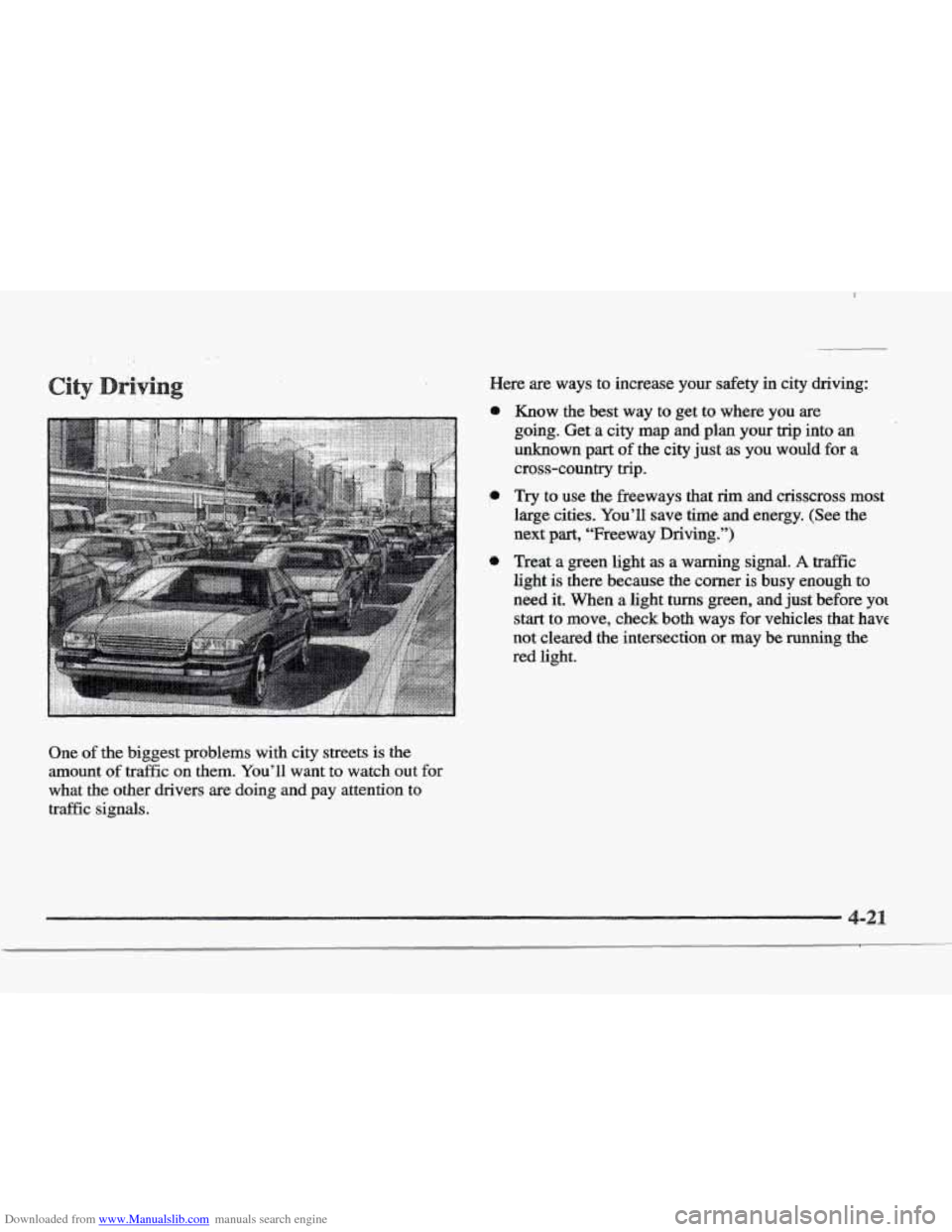
Downloaded from www.Manualslib.com manuals search engine .. .. . t. . :.
One of the biggest problems with city streets is the
amount
of traffic on them. You’ll want to watch out for
what the other drivers are doing and pay attention to
traffic
signals.
Here are ways to increase your safety in city driving:
a
a
Know the best way to get to where you are
going. Get
a city map and plan your trip into an
unknown part of the city just as you would for a
cross-country trip.
Try to use the freeways that rim and crisscross most
large cities.
You’ll save time and energy. (See the
next part, “Freeway Driving.”)
Treat a green light as a warning signal. A traffic
light
is there because the comer is busy enough to
need
it. When a light turns green, and just.before yo[
start to move, check both ways for vehicles that have
not cleared the intersection
or may be running the
red light.
Page 207 of 361
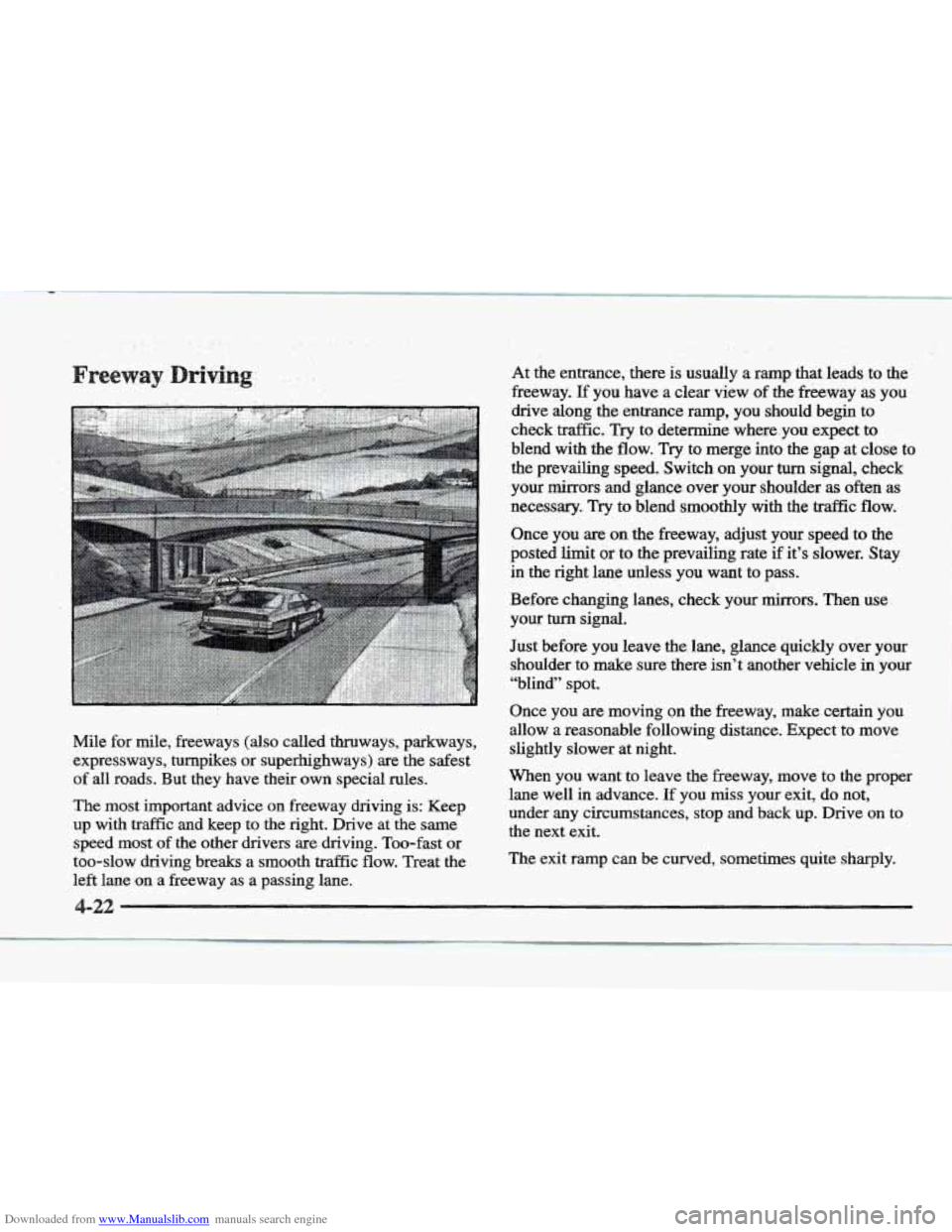
Downloaded from www.Manualslib.com manuals search engine Mile for mile, freeways (also called thruways, parkways,
expressways, turnpikes or superhighways) are the safest
of all roads. But they have their own special rules.
The most important advice on freeway driving is: Keep
up with traffic and keep to the right. Drive at the same
speed most
of the other drivers are driving. Too-fast or
too-slow driving breaks a
smooth traffic flow. Treat the
left lane
on a freeway as a passing lane. At
the entrance, there is usually a ramp that leads to the
freeway. If you have a clear view of the freeway as you
drive along the entrance ramp, you should begin to
check trafl5c.
Try to determine where. you expect to
blend with the
flow. Try to ,merge into the gap at close to
the prevailing speed. Switch on your turn Signal, check-
your mirrors and,glance..over
your shoulder as often as
necessary. Try to blend'smoothly with the traffic flow.
Once
you are on the freeway, adjust your speed to the
posted limit or to the prevailing rate if it's
slower. Stay
in the right lane unless you want to pass.
Before changing lanes, check your mirrors. Then use
your
turn signal.
Just before you leave the. lane, glance quickly over your
shoulder to make sure there isn't another vehicle in your
"blind" spot.
Once you
are moving on the freeway, make certain you
allow a reasonable following distance. Expect to move
slightly slower at night.
When you want to leave the freeway, move to the proper
lane well in advance. If you
miss your exit, do not,
under any circumstances, stop and back up. Drive
on to
the next exit.
The exit ramp can be curved, sometimes quite sharply.
Page 208 of 361
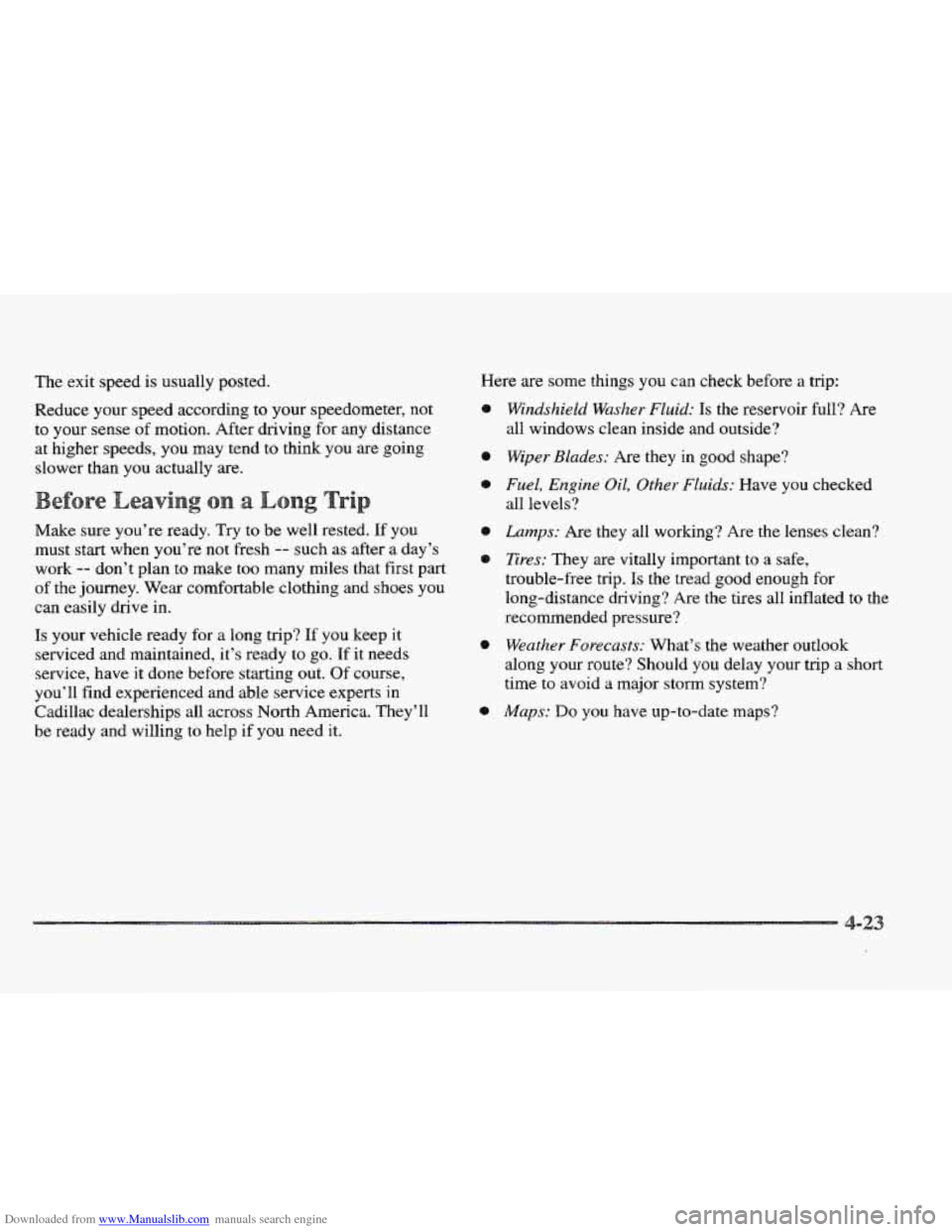
Downloaded from www.Manualslib.com manuals search engine The exit speed is usually posted.
Reduce your speed according to your speedometer, not
to your sense
of motion. After driving for any distance
at higher speeds, you may tend
to think you are going
slower than you actually are.
v
Make sure you’re ready. Try to be well rested. If you
must start when you’re not fresh
-- such as after a day’s
work
-- don’t plan to make too many miles that first part
of the journey. Wear comfortable clothing and shoes you
can easily drive in.
Is your vehicle ready for a long trip? If you keep
it
serviced and maintained, it’s ready to go. If it needs
service, have
it done before starting out. Of course,
you’ll find experienced and able service experts
in
Cadillac dealerships all across North America. They’ll
be ready and willing to help if you need it. Here
are some things you can check before
a trip:
e
e
QB
Q
Q
Windshield Washer Fluid: Is the reservoir full? Are
all windows clean inside and outside?
Wiper Blades: Are they in good shape?
Fuel, Engine Oil, Other Fluids: Have you checked
all levels?
Lamps: Are they all working? Are the lenses clean?
Tires: They are vitally important to a safe,
trouble-free trip. Is the tread good enough for
long-distance driving? Are the tires all inflated
to the
recommended pressure?
Weather Forecasts: What’s the weather outlook
along your route? Should you delay your trip a short
time to avoid
a major storm system?
Maps: Do you have up-to-date maps?
Page 209 of 361
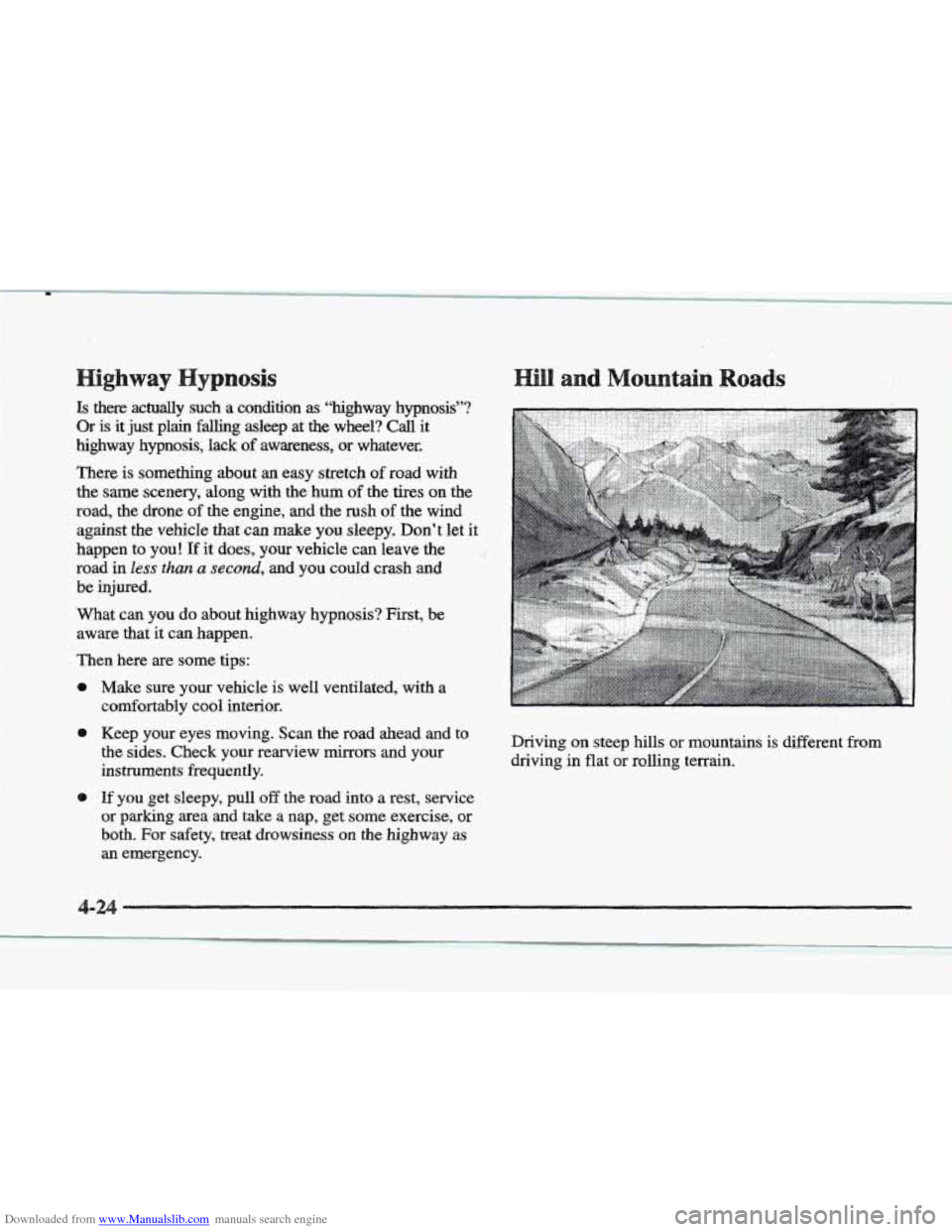
Downloaded from www.Manualslib.com manuals search engine Is there actually such a condition as “highway hypnosis”?
Or is it just plain
falling asleep at the wheel? Call it
highway hypnosis, lack
of awareness, or whatever.
There is something.about
an easy stretch of road with
the same scenery, along with the hum of the tires on the
road, the drone
of the engine, and the rush of the wind
against
the vehicle that can make you sleepy. Don’t let it
happen to you!
If it does, your vehicle .can leave the
road
in less than a second, and you could crash and
be injured.
What can you
do about highway hypnosis? First, be
aware that it can happen.
Then here
are some tips:
e
e
Make sure your vehicle is well ventilated, with a
comfortably cool interior.
Keep your eyes moving. Scan the road ahead
and to
the sides. Check your rearview mirrors
and your
instruments frequently.
If you get sleepy, pull off the road into a rest, service
or parking area
and take a nap, get some exercise, or
both. For safety, treat drowsiness on the highway as
an emergency. Driving on steep hills or mountains is different from
driving
in flat or rolling terrain.
Page 210 of 361
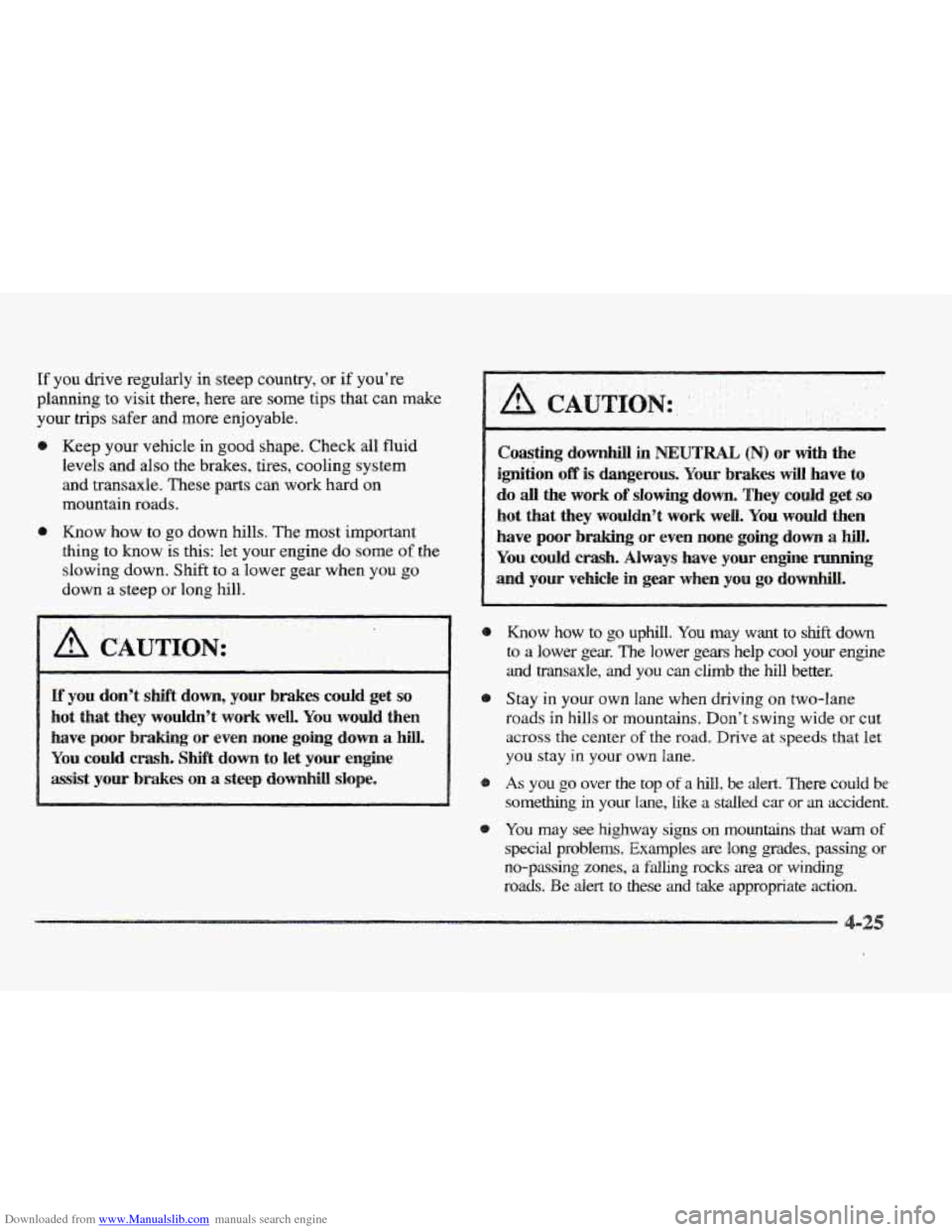
Downloaded from www.Manualslib.com manuals search engine If you drive regularly in steep country, or if you’re
planning to visit there, here are some tips that can
make
your trips safer and more enjoyable.
Keep your vehicle
in good shape. Check all fluid
levels and also the brakes, tires, cooling system
and transaxle. These parts can work hard on
mountain roads.
Know how to
go down hills. The most important
thing to know
is this: let your engine do some of the
slowing down. Shift to a lower gear when you go
down a steep or long hill.
~ ~ ~~ -~ ~
Coasting downhill in NEUTRAL (N) or with the
ignition off is dangerous. Your brakes will have to
do dl the work of slowing down. They codd get so
hot that they woddn9t work well. You would then
have poor braking QF even none going down a hill.
You ~dd crash. Always have your engine running
Saaaca your vehicle in gear when you go doMi.
A CAUTION:
you don’t shift down, your brakes could get so
hot that they wouldn’t work well. You would then
have
poor braking or even none going down a hu.
You could crash. Shift down to let your engine
mist
your brakes on a steep downhill slope.
Know how to go uphill. You may want to shift down
to a lower gear. The lower gears help cool your engine
and transaxle, and you
can climb the hill better.
Stay
in your own lane when driving on two-lane
roads in hills OF mountains. Don’t swing wide or cut
across the center
of the road. Drive at speeds that let
you stay
in your own lane.
As you go over the top of a hill, be alert. There could be
something in your lane, like a stalled car or an accident.
You may see highway signs on mountains that warn of
special problems. Examples are Bong grades, passing or
no-passing zones, a falling rocks area or winding
roads. Be
dert to these and take appropriate action.
-2
Page 214 of 361
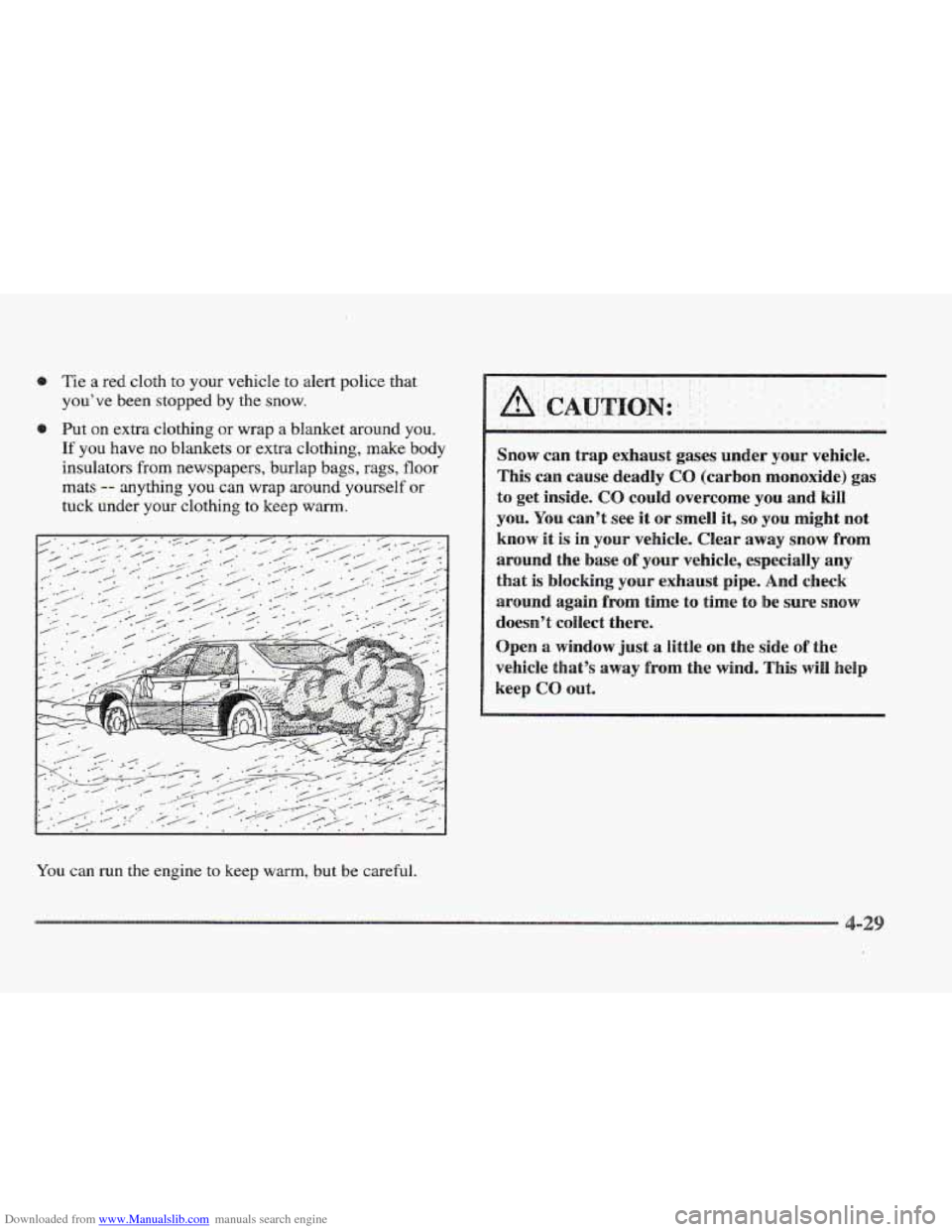
Downloaded from www.Manualslib.com manuals search engine Tie a red cloth to your vehicle to alert police that
you’ve been stopped by the snow.
Put
on extra clothing or wrap a blanket around you.
If you have no blankets or extra clothing, make body
insulators from newspapers, burlap bags, rags,
floor
mats -- anything you can wrap around yourself or
tuck under your clothing to keep warm.
You can run the engine to keep warm, but be careful.
Snow can trap exhaust gases under your vehicle.
This can cause deadly
CO (carbon monoxide) gas
to get inside. CO could overcome you and kill
you. You can’t see it or smell it, so you might not
know it is in your vehicle. Clear away snow from
around the base of your vehicle, especially any
locking your exhaust ipe. And check
around again from time to time to be sure snow
doesn’t collect there.
pen
a window just a little on the side of the
vehicle
that’s away from the wind. This will he8
keep CO out.
Page 221 of 361
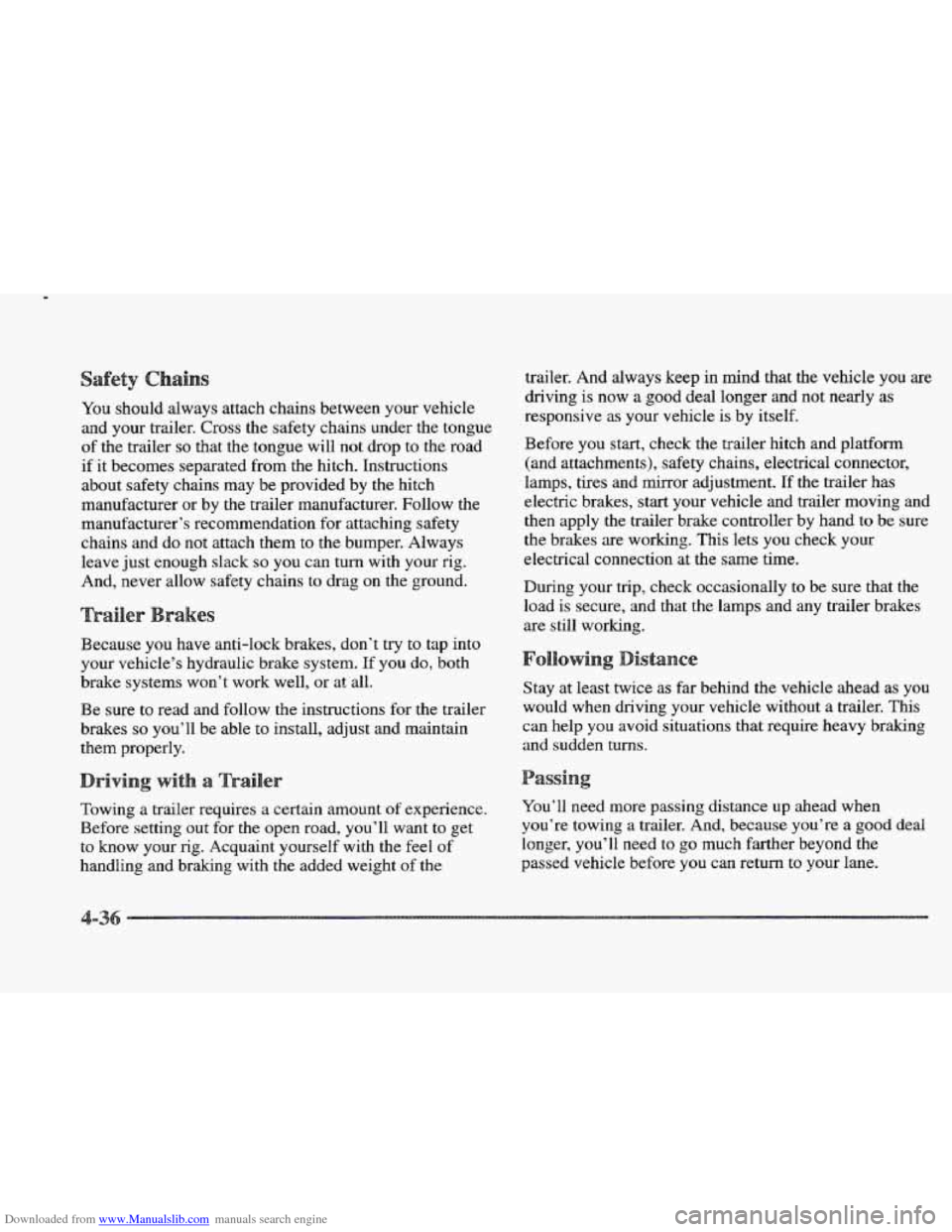
Downloaded from www.Manualslib.com manuals search engine You should always attach chains between your vehicle
and your trailer. Cross the safety chains under the tongue
of the trailer
so that the tongue will not drop to the road
if it becomes separated from the
hitch. Instructions
about safety chains may be provided by the hitch
manufacturer or by
the trailer manufacturer. Follow the
manufacturer’s recommendation
for attaching safety
chains and do
not attach them to the bumper. Always
leave just enough slack
so you can turn with your rig.
And, never allow safety chains to drag
on the ground.
Because you have anti-lock brakes, don’t
try to tap into
your vehicle’s hydraulic brake system.
If you do, both
brake systems won’t work well, or at all.
Be
sure to read and follow the instructions for the trailer
brakes
so you’ll be able to install, adjust and maintain
them properly.
Towing a trailer requires a certain amount
of experience.
Before setting out for
the open road, you’ll want to get
to know your
rig. Acquaint yourself with the feel of
handling and braking with the added weight of the trailer. And always
keep
in mind that the vehicle you are
driving is now a good deal longer and not nearly as
responsive
as your vehicle is by itself.
Before you start, check the trailer hitch and platform
(and attachments), safety chains, electrical connector,
lamps, tires and mirror adjustment.
If the trailer has
electric brakes, start your vehicle and trailer moving
and
then apply the trailer brake controller by hand to be sure
the brakes are working. This lets you check your
electrical connection at the same time.
During your trip, check occasionally to be sure that
the
load is secure, and that the lamps and any trailer brakes
are still working.
Stay at least twice as far behind the vehicle ahead as you
would when driving your vehicle without a trailer. This
can help you avoid situations that require heavy braking
and sudden turns.
You’ll need more passing distance
up ahead when
you’re towing
a trailer. And, because you’re a good deal
longer, you’ll need to
go much farther beyond the
passed vehicle before you can return to your lane.
Page 222 of 361
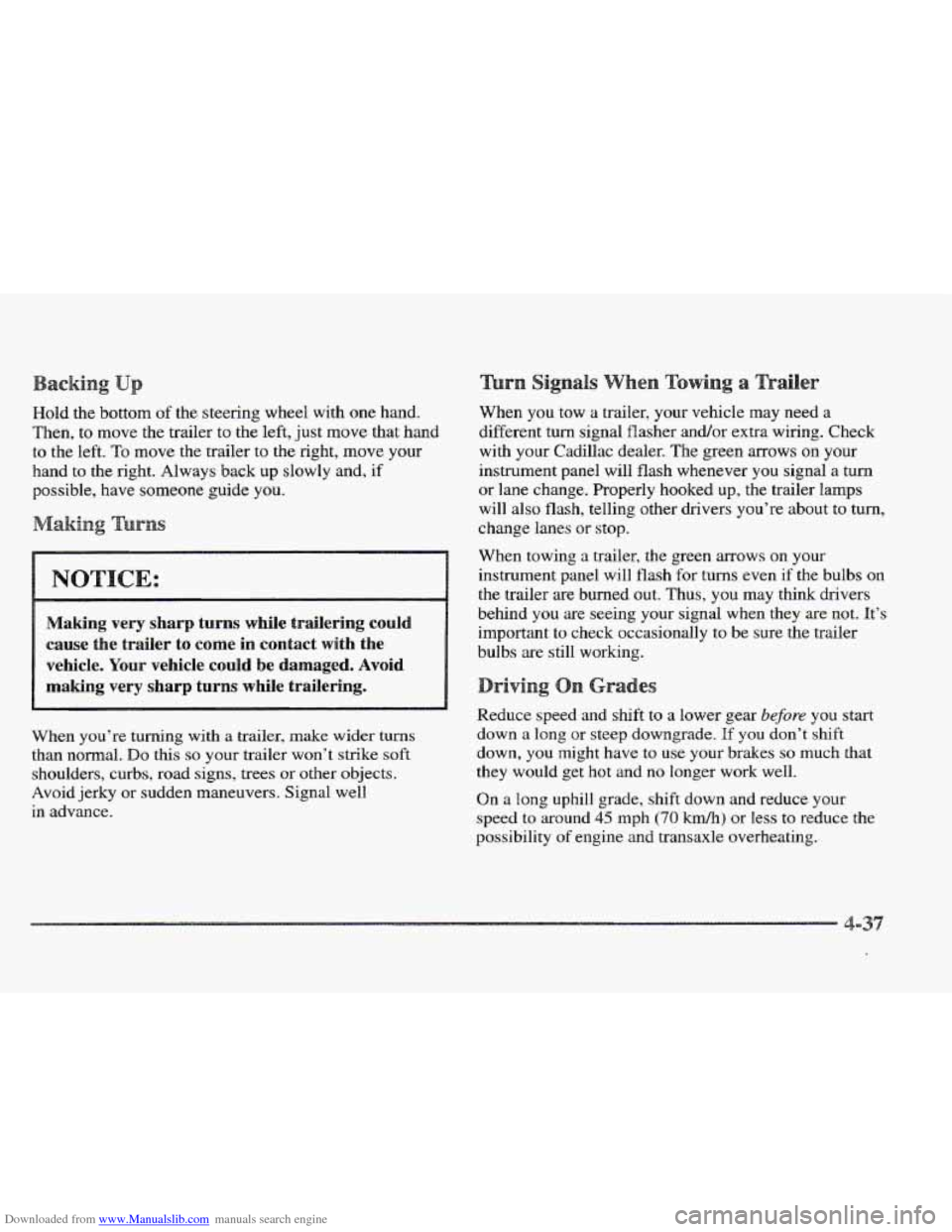
Downloaded from www.Manualslib.com manuals search engine Hold the bottom of the steering wheel with one hand.
Then, to move the trailer to the left, just move that hand
to the left. TQ move the trailer to the right, move your
hand
to the right. Always back up slowly and, if
possible,
have someone guide you. When
you tow a trailer, your vehicle may need
a
different turn signal flasher andor extra wiring. Check
with your Cadillac dealer. The green
arrows on your
instrument panel will flash whenever you signal a turn
or lane change. Properly hooked up, the trailer lamps
will also flash, telling other drivers you’re about to turn,
change lanes or stop.
When towing
a trailer, the green arrows on your
instrument
panel will flash for turns even if the bulbs on
the trailer are burned out. Thus, you may think drivers
Making very sharp turns while trailerring could
cause
the trailer to come in contact with the
vehicle.
Your vehicle could be damaged. Avoid
behind you are seeing your signal wheithey are mot. It’s
important to check occasionally to be sure the trailer
bulbs are still working.
-
making very sharp turns while traillering.
Reduce speed and shift to a lower gear before you start
When you’re turning with a trailer, make wider turns down a long or steep downgrade. If you don’t shift
than normal. Do this so your trailer won’t strike soft down, you might have to use your brakes so much that
shoulders, curbs, road
signs, trees or other objects. they would get hot and no longer work well.
Avoid jerky
or sudden maneuvers. Signal well
in advance. speed to around
45 mph (70 kdh) or less to reduce the
On
a long
uphill grade, shift down and reduce your
possibility
of engine and transaxle overheating.